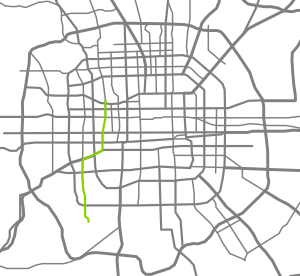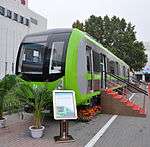Line 9 (Beijing Subway)
Line 9 of the Beijing Subway (Chinese: 北京地铁9号线; pinyin: běijīng dìtiě jiǔhào xiàn) is a rapid transit line in western Beijing. The line runs 16.5 km (10.3 mi) from the National Library in Haidian District to Guogongzhuang in Fengtai District with 13 stations. All stations are fully underground. Line 9's color is chartreuse.
| Line 9 | ||||||||||||||||||||||||||||||||||||||||||||||||||||||||||||||||||||||||||||||||||||||||||||||||||||||||||||||||||||||||||||||||||||||||||||||||||||||||||||||||||||||||||||||||||||||||||||||||||||||||||||||||||||||||||||||||||||||||||||||||||||||||||||||||||||||||||||||||||
|---|---|---|---|---|---|---|---|---|---|---|---|---|---|---|---|---|---|---|---|---|---|---|---|---|---|---|---|---|---|---|---|---|---|---|---|---|---|---|---|---|---|---|---|---|---|---|---|---|---|---|---|---|---|---|---|---|---|---|---|---|---|---|---|---|---|---|---|---|---|---|---|---|---|---|---|---|---|---|---|---|---|---|---|---|---|---|---|---|---|---|---|---|---|---|---|---|---|---|---|---|---|---|---|---|---|---|---|---|---|---|---|---|---|---|---|---|---|---|---|---|---|---|---|---|---|---|---|---|---|---|---|---|---|---|---|---|---|---|---|---|---|---|---|---|---|---|---|---|---|---|---|---|---|---|---|---|---|---|---|---|---|---|---|---|---|---|---|---|---|---|---|---|---|---|---|---|---|---|---|---|---|---|---|---|---|---|---|---|---|---|---|---|---|---|---|---|---|---|---|---|---|---|---|---|---|---|---|---|---|---|---|---|---|---|---|---|---|---|---|---|---|---|---|---|---|---|---|---|---|---|---|---|---|---|---|---|---|---|---|---|---|---|---|---|---|---|---|---|---|---|---|---|---|---|---|---|---|---|---|---|---|---|---|---|---|---|---|---|---|---|---|---|---|---|
| 9 | ||||||||||||||||||||||||||||||||||||||||||||||||||||||||||||||||||||||||||||||||||||||||||||||||||||||||||||||||||||||||||||||||||||||||||||||||||||||||||||||||||||||||||||||||||||||||||||||||||||||||||||||||||||||||||||||||||||||||||||||||||||||||||||||||||||||||||||||||||
Liuliqiao station platform in 2011 | ||||||||||||||||||||||||||||||||||||||||||||||||||||||||||||||||||||||||||||||||||||||||||||||||||||||||||||||||||||||||||||||||||||||||||||||||||||||||||||||||||||||||||||||||||||||||||||||||||||||||||||||||||||||||||||||||||||||||||||||||||||||||||||||||||||||||||||||||||
| Overview | ||||||||||||||||||||||||||||||||||||||||||||||||||||||||||||||||||||||||||||||||||||||||||||||||||||||||||||||||||||||||||||||||||||||||||||||||||||||||||||||||||||||||||||||||||||||||||||||||||||||||||||||||||||||||||||||||||||||||||||||||||||||||||||||||||||||||||||||||||
| Other name(s) | M9 (planned name) | |||||||||||||||||||||||||||||||||||||||||||||||||||||||||||||||||||||||||||||||||||||||||||||||||||||||||||||||||||||||||||||||||||||||||||||||||||||||||||||||||||||||||||||||||||||||||||||||||||||||||||||||||||||||||||||||||||||||||||||||||||||||||||||||||||||||||||||||||
| Type | Rapid transit | |||||||||||||||||||||||||||||||||||||||||||||||||||||||||||||||||||||||||||||||||||||||||||||||||||||||||||||||||||||||||||||||||||||||||||||||||||||||||||||||||||||||||||||||||||||||||||||||||||||||||||||||||||||||||||||||||||||||||||||||||||||||||||||||||||||||||||||||||
| System | Beijing Subway | |||||||||||||||||||||||||||||||||||||||||||||||||||||||||||||||||||||||||||||||||||||||||||||||||||||||||||||||||||||||||||||||||||||||||||||||||||||||||||||||||||||||||||||||||||||||||||||||||||||||||||||||||||||||||||||||||||||||||||||||||||||||||||||||||||||||||||||||||
| Status | Operational | |||||||||||||||||||||||||||||||||||||||||||||||||||||||||||||||||||||||||||||||||||||||||||||||||||||||||||||||||||||||||||||||||||||||||||||||||||||||||||||||||||||||||||||||||||||||||||||||||||||||||||||||||||||||||||||||||||||||||||||||||||||||||||||||||||||||||||||||||
| Locale | Fengtai and Haidian districts Beijing | |||||||||||||||||||||||||||||||||||||||||||||||||||||||||||||||||||||||||||||||||||||||||||||||||||||||||||||||||||||||||||||||||||||||||||||||||||||||||||||||||||||||||||||||||||||||||||||||||||||||||||||||||||||||||||||||||||||||||||||||||||||||||||||||||||||||||||||||||
| Termini | National Library Guogongzhuang | |||||||||||||||||||||||||||||||||||||||||||||||||||||||||||||||||||||||||||||||||||||||||||||||||||||||||||||||||||||||||||||||||||||||||||||||||||||||||||||||||||||||||||||||||||||||||||||||||||||||||||||||||||||||||||||||||||||||||||||||||||||||||||||||||||||||||||||||||
| Stations | 13 | |||||||||||||||||||||||||||||||||||||||||||||||||||||||||||||||||||||||||||||||||||||||||||||||||||||||||||||||||||||||||||||||||||||||||||||||||||||||||||||||||||||||||||||||||||||||||||||||||||||||||||||||||||||||||||||||||||||||||||||||||||||||||||||||||||||||||||||||||
| Daily ridership | 460,800 (2014 Avg.) 637,900 (2016 Peak)[1] | |||||||||||||||||||||||||||||||||||||||||||||||||||||||||||||||||||||||||||||||||||||||||||||||||||||||||||||||||||||||||||||||||||||||||||||||||||||||||||||||||||||||||||||||||||||||||||||||||||||||||||||||||||||||||||||||||||||||||||||||||||||||||||||||||||||||||||||||||
| Operation | ||||||||||||||||||||||||||||||||||||||||||||||||||||||||||||||||||||||||||||||||||||||||||||||||||||||||||||||||||||||||||||||||||||||||||||||||||||||||||||||||||||||||||||||||||||||||||||||||||||||||||||||||||||||||||||||||||||||||||||||||||||||||||||||||||||||||||||||||||
| Opened | December 31, 2011 | |||||||||||||||||||||||||||||||||||||||||||||||||||||||||||||||||||||||||||||||||||||||||||||||||||||||||||||||||||||||||||||||||||||||||||||||||||||||||||||||||||||||||||||||||||||||||||||||||||||||||||||||||||||||||||||||||||||||||||||||||||||||||||||||||||||||||||||||||
| Operator(s) | Beijing Mass Transit Railway Operation Corp., Ltd | |||||||||||||||||||||||||||||||||||||||||||||||||||||||||||||||||||||||||||||||||||||||||||||||||||||||||||||||||||||||||||||||||||||||||||||||||||||||||||||||||||||||||||||||||||||||||||||||||||||||||||||||||||||||||||||||||||||||||||||||||||||||||||||||||||||||||||||||||
| Character | Underground | |||||||||||||||||||||||||||||||||||||||||||||||||||||||||||||||||||||||||||||||||||||||||||||||||||||||||||||||||||||||||||||||||||||||||||||||||||||||||||||||||||||||||||||||||||||||||||||||||||||||||||||||||||||||||||||||||||||||||||||||||||||||||||||||||||||||||||||||||
| Rolling stock | 6-car Type B (DKZ33) | |||||||||||||||||||||||||||||||||||||||||||||||||||||||||||||||||||||||||||||||||||||||||||||||||||||||||||||||||||||||||||||||||||||||||||||||||||||||||||||||||||||||||||||||||||||||||||||||||||||||||||||||||||||||||||||||||||||||||||||||||||||||||||||||||||||||||||||||||
| Technical | ||||||||||||||||||||||||||||||||||||||||||||||||||||||||||||||||||||||||||||||||||||||||||||||||||||||||||||||||||||||||||||||||||||||||||||||||||||||||||||||||||||||||||||||||||||||||||||||||||||||||||||||||||||||||||||||||||||||||||||||||||||||||||||||||||||||||||||||||||
| Line length | 16.5 km (10.3 mi) | |||||||||||||||||||||||||||||||||||||||||||||||||||||||||||||||||||||||||||||||||||||||||||||||||||||||||||||||||||||||||||||||||||||||||||||||||||||||||||||||||||||||||||||||||||||||||||||||||||||||||||||||||||||||||||||||||||||||||||||||||||||||||||||||||||||||||||||||||
| Track gauge | 1,435 mm (4 ft 8 1⁄2 in) standard gauge | |||||||||||||||||||||||||||||||||||||||||||||||||||||||||||||||||||||||||||||||||||||||||||||||||||||||||||||||||||||||||||||||||||||||||||||||||||||||||||||||||||||||||||||||||||||||||||||||||||||||||||||||||||||||||||||||||||||||||||||||||||||||||||||||||||||||||||||||||
| Electrification | 750 V DC Third rail | |||||||||||||||||||||||||||||||||||||||||||||||||||||||||||||||||||||||||||||||||||||||||||||||||||||||||||||||||||||||||||||||||||||||||||||||||||||||||||||||||||||||||||||||||||||||||||||||||||||||||||||||||||||||||||||||||||||||||||||||||||||||||||||||||||||||||||||||||
| Operating speed | 80 km/h (50 mph) | |||||||||||||||||||||||||||||||||||||||||||||||||||||||||||||||||||||||||||||||||||||||||||||||||||||||||||||||||||||||||||||||||||||||||||||||||||||||||||||||||||||||||||||||||||||||||||||||||||||||||||||||||||||||||||||||||||||||||||||||||||||||||||||||||||||||||||||||||
| ||||||||||||||||||||||||||||||||||||||||||||||||||||||||||||||||||||||||||||||||||||||||||||||||||||||||||||||||||||||||||||||||||||||||||||||||||||||||||||||||||||||||||||||||||||||||||||||||||||||||||||||||||||||||||||||||||||||||||||||||||||||||||||||||||||||||||||||||||
History

In 1989, the State Council decided to build Beijing West railway station on the Beijing-Kowloon railway. Subway planning had determined that Beijing West railway station would be the interchange between Lines 7 and 9. However, no provision for an interchange station was added in the railway station's design. The railway station was completed in 1996.[2] 15 years later Beijing West Station was rebuilt and expanded with provisions added to the basement of the station for Lines 7 and 9.[3] In 2002, in preparation for the 2008 Beijing Olympics, it was proposed that the first section of Line 9 should be built between Baishiqiao and Beijing West railway station (today's National Library to Beijing West railway station section). The entire length of the proposed line was 5.8 kilometers.[4] However, the line only started construction in April 2007,[5] with a planned opening date of 2010[6] and the original northern section between Baishiqiao to Beijing West Station was further delayed until 2012,[7] making an opening before the Olympics unlikely.
On December 31, 2011 the 11.1 km (6.9 mi), nine-station southern section from Guogongzhuang to Beijing West railway station opened.[8][9] At the time the line was only connected to the Fangshan Line, isolated from the rest of the Beijing Subway network.[10] Passengers had to transfer to shuttle buses that connected to the main subway network to continue their journey.,[11] making the line sparsely used in 2011. The situation did not improve on April 29, 2012 when the Beijing subway exceeded a record 8 million daily riders, with the daily ridership of Line 9 being only 46,300 as it was still isolated from the rest of the network.[12]
On December 30, 2012, the original northern section from the Beijing West railway station to the National Library entered into operation. This finally connected Line 9 and the Fangshan Line to the rest of the subway network and made all major Beijing train stations accessible by subway.[13] The underground connections for the transfer between Line 9 and Line 1 were not completed at the opening of the Line 9 extension.[14] Between December 2012 and December 2013, Line 9 skipped Military Museum station.[15] Line 9's passenger traffic began to grow rapidly after the northern section went into operation. As of January 2013, the average daily passenger traffic was already three times higher than in December 2012,[16] at 220,000 rides.[17] The Line 1 to Line 9 transfer was completed at the Military Museum Station on December 21, 2013.
| Segment | Commencement | Length | Station(s) | Name |
|---|---|---|---|---|
| Beijing West railway station — Guogongzhuang | 31 December 2011 | 5.349 km (3.32 mi) | 8 | (southern section) |
| Fengtai Dongdajie | 12 October 2012 | Infill station | 1 | |
| National Library — Beijing West railway station | 30 December 2012 | 10.282 km (6.39 mi) | 3 | (northern section) |
| Military Museum | 21 December 2013 | Infill station | 1 |
List of Stations
| Station Name | Connections | Nearby Bus Stops | Distance km[18] |
Location | ||
|---|---|---|---|---|---|---|
| English | Chinese | |||||
| National Library | 国家图书馆 | 4 | 86 92 305 320 332 481 563 609 653 658 695 特19 夜8 | 0.000 | 0.000 | Haidian |
| Baishiqiao South | 白石桥南 | 6 | 27 61 86 92 114 118 320 653 693 701 夜3 | 1.096 | 1.096 | |
| Baiduizi | 白堆子 | 10 61 92 121 612 686 BRT4(快速公交4) 夜13 | 0.943 | 2.039 | ||
| Military Museum | 军事博物馆 | 1 | 1 21 40 52 65 68 78 85 94 308 414 夜1 夜5 夜8 | 1.912 | 3.951 | |
| Beijing West railway station | 北京西站 | 7 |
3 9 21 40 42 50 52 53 62 65 67 89 96 109 122 309 320 339 349 374 387 394 410 414 616 663 694 820 890 901快 917快 941 941快 968 982 997 特2 特13 特14 特19 夜5 夜8 夜14 夜15 夜22 夜23 夜36 专138 | 1.398 | 5.349 | Fengtai |
| Liuliqiao East | 六里桥东 | 6 38 57 74 76 133 134 309 321 349 390 477 691 820 832 835快 836 838 890 895 917 917快 941 941快 968 971 982 特7 夜7 | 1.170 | 6.519 | ||
| Liuliqiao | 六里桥 | 10 | 57 133 477 554 568 603 941 941快 982 专3 | 1.309 | 7.828 | |
| Qilizhuang | 七里庄 | 14 | 77 83 323 458 477 480 483 531 830 839 840 896 958 969 973 特7 特9 夜16 夜36 专3 | 1.778 | 9.606 | |
| Fengtai Dongdajie | 丰台东大街 | 335 349 395 459 477 678 845 夜16 | 1.325 | 10.931 | ||
| Fengtainanlu | 丰台南路 | 351 353 602 627 691 736 845 夜7 | 1.585 | 12.516 | ||
| Keyilu | 科怡路 | 83 685 694 740 912 特7 特9 | 0.980 | 13.496 | ||
| Fengtai Science Park | 丰台科技园 | 470 专63 969 | 0.788 | 14.284 | ||
| Guogongzhuang | 郭公庄 | Fangshan | 470 497 627 969 | 1.347 | 15.631 | |
Rolling Stock
Line 9 is served by a fleet of 37 6-car DKZ33 trains built by CNR Changchun.[19]
| Model | Image | Manufacturer | Year Built | Amount in Service | Fleet Numbers | Depot |
|---|---|---|---|---|---|---|
| DKZ33 |  |
CRRC Changchun Railway Vehicles | 2011, 2019 | 37 | 09 001–09 037 | Guogongzhuang |
Gallery
- Line 9
- Liuliqiao station platform
- Liuliqiao station concourse
- Guogongzhuang station platform
References
- 2014年4月30日综合交通总体运行情况. 北京市交通信息中心 北京市交通运行监测调度中心. Archived from the original on 2014-05-02. Retrieved 2014-05-02. |date=2014-05-01}}
- 北京西客站预埋工程 (doc). 北京城建设计研究总院. Retrieved 2013-01-19.
- "五一"期间北京市万名地铁建设者坚守岗位. 2011-05-03. Retrieved 2013-01-19.
- 北京奥运交通规划新建8条地铁线. 2002-12-02. Retrieved 2013-01-18.
- 北京地铁9号线4月份已开工建设 沿线房价猛涨. 2007-11-18. Retrieved 2013-01-18.
- 北京地铁九号线本月开工 将建首条"水下通道". 2007-04-04. Retrieved 2013-01-18.
- Guo Kun (郭鲲 (2008-12-18). 北京4条地铁线路有望2012年通车. Retrieved 2013-01-18.
- Xu, Wei. "Beijing launches three new subway sections". China Daily. Retrieved 2012-01-01.
- 9号线南段将于2011年年底开通试运营. 北京市交通委员会. 2011-12-09. Retrieved 2013-01-18. [Beijing Municipal Transportation Committee]
- Deng Hang (邓杭) (2011-03-30). 北京地铁9号线南段9月试运行 12月底开通运营. Retrieved 2013-01-18.
- Liu Mian (刘冕) (2011-12-08). 北京地铁9号线南段本月底将开通试运营. Retrieved 2013-01-18.
- 北京地铁昨天全路网日客运量首破800万高达839.1万人次. 2012-04-29. Archived from the original on 2012-05-02. Retrieved 2013-01-18.
- 本市四条地铁新线暂定12月30日开通. Beijing Daily (in Chinese). Archived from the original on 2012-12-10. Retrieved 19 December 2012.
- (Chinese) 北京地铁公布最新线路全图 [Beijing Subway releases a map of the full Beijing subway network.]. Beijing Youth Daily. Archived from the original on 2012-12-17.
- (Chinese) 北京地铁4新线周日开通 9号线军博不停车. The Beijing News. Retrieved 27 December 2012.
- 轨道新线逐步发挥优化均衡全线网客流结构作用. 北京市交通委员会. 2013-01-16. Retrieved 2013-01-18.[Beijing Municipal Transportation Committee] |url-status=dead |archiveurl= |archivedate=2013-01-26 |df= }}
- 四条新线开通试运营后发挥作用明显. 北京市重大项目建设指挥部办公室. 2013-01-16. Archived from the original on 2013-11-05. Retrieved 2013-01-18.
- "站间公里数 北京地铁官方网站".
- 北车制造近千辆地铁车辆支撑北京四条地铁开通运营. 2013-01-04. Archived from the original on 2013-01-16. Retrieved 2013-01-19.